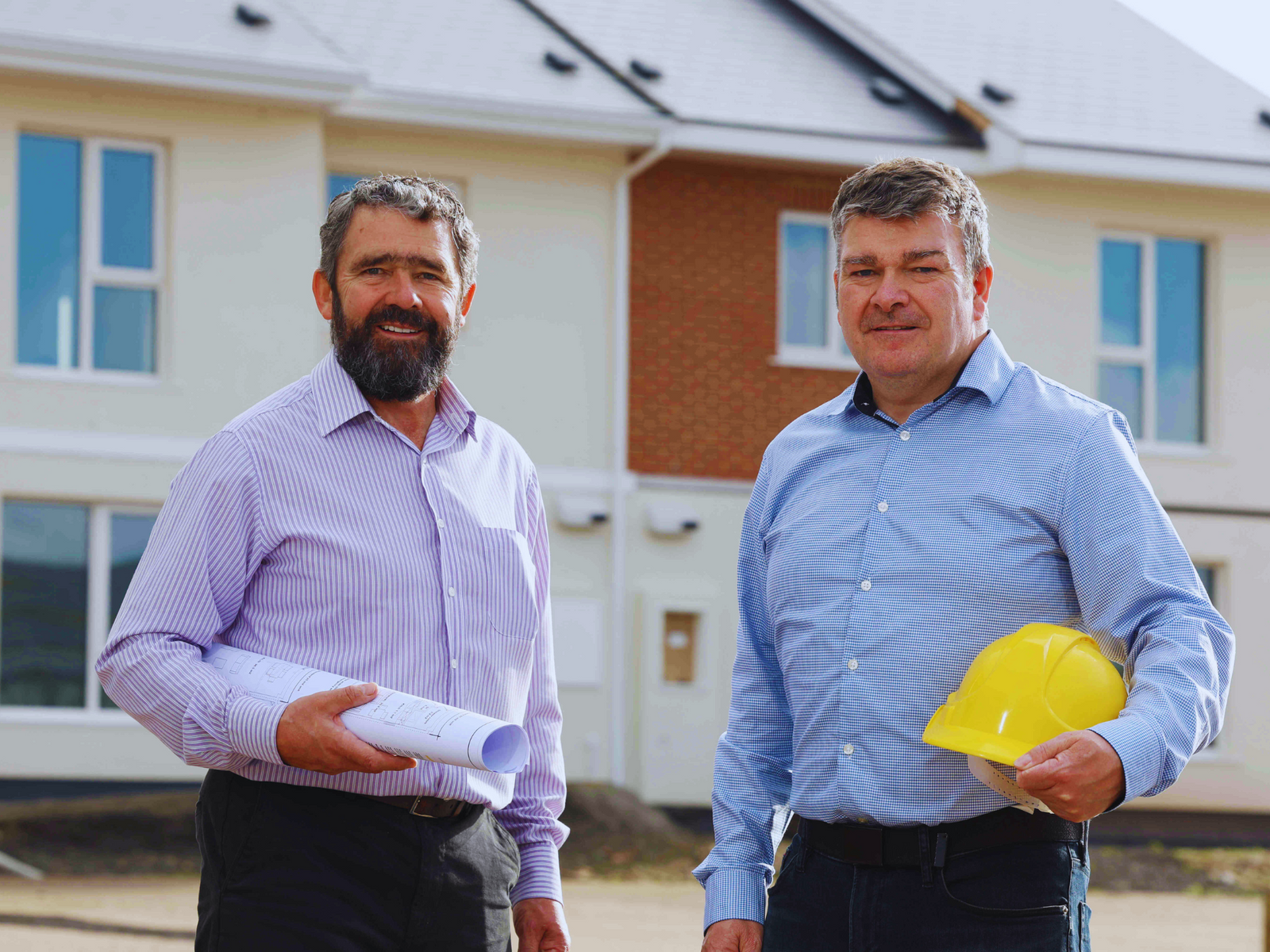
The Big Interview: The future is modular for innovative Magherafelt joinery firm Setanta Construction
Ambitious projects for Claridge’s Hotel in London and an art gallery in France opened Setanta Construction’s eyes to the potential of building energy efficient homes off-site, director Mark Gribbin reveals
Mark and Niall Gribbin, Directors of Setanta Construction
Credit: Alyson Magee, January 17 2023

A local joinery business is piloting a modular ‘passive’ house expected to cost as little as £150 a year to heat. Two prototypes have been built on Setanta Construction’s 15-acre premises in Magherafelt and are being monitored by Ulster University researchers for a year.
The family firm, run by brothers Mark and Niall Gribbin, is now focusing on modular homes as the future.
Providing a solution to the skills shortage in the sector, modular buildings can also potentially offer a quick turnaround as emergency housing.
Setanta has been inspired by its off-site work for Claridge’s in London, featured in BBC Two’s The Mayfair Hotel Megabuild.
It also built modular components for another project led by the hotel’s boss Paddy McKillen, the Richard Rogers Art Gallery in France.

“The passive house concept is German, the modular concept is our own, and it’s coming from our experience of Claridge’s and the Rogers Gallery,” said Mark.
“If we can do this for a Victorian hotel in London and an art gallery in France, why can’t we do it for standard construction at home?
“The passive house concept we’ve been fans of for years, and we know it’s the gold standard in energy efficient building, which is probably the most important element in people’s minds today.”
Accessed across a short bridge, and purposely taking in the amazing views of the Provence landscape, the Richard Rogers’ Drawing Gallery is almost entirely suspended with only four small footings touching the ground.
The prototypes are three-bedroom semi-detached properties constructed to be comfortable, affordable and energy efficient, with high levels of insulation.
Warmth comes from a combined heat pump and mechanical ventilation system.
“It’s quite ground-breaking and has caught the attention of the social housing sector,” he added.
“There is a projected energy usage, but in 12 months we’ll have the actual figures of what it takes to heat this house for 12 months. This is where we’ll be concentrating our efforts.”
While early interest has come from social housing, Setanta sees wider opportunity for the innovation in private housing.
“In years gone by people’s wish-list had energy efficiency well down the priorities, but now it’s at the top,” he said.
“We’re looking at emergency accommodation, which is a new need for local councils and the like coming from the Ukrainian war, refugees and possibly leaning towards the homeless.”
Building homes in a factory is much more efficient, with less wastage than on-site construction and zero concerns over our unpredictable weather.
A further benefit is it requires a less-demanding skills set than on-site construction.
“We’re all noticing there are fewer and fewer apprentices coming through the trades,” Mark said.

“With Northern Ireland companies, there are really good tradesmen around, but the average age on-site would be mid-50s. In 10-15 years’ time the skills shortage is going to be an issue.”
Setanta provided off-site constructed building enclosure components for the Richard Rogers’ Drawing Gallery in the south of France, named Small Building of the Year at the Dezeen Architecture Awards 2022
The main challenge around modular construction is moving the parts.
“There are limitations to the size you can put in the back of a lorry, the width of a public road and the height with getting under bridges,” he explained.
“Those limitations were also influencing factors in our designs for Claridge’s. We had to design it to… how do we split this thing apart and where do we split it and how do we make it not too big, too wide or too tall for transport?
“But once you can get it within those parameters of height, width and length, then you can design whatever you wish.”
Another key advantage is it allows Setanta to take on projects outside its normal geographic scope.
One project, for example, is a modular build of 22 units in Waterford with 95-98% of the work to be done in Magherafelt
“If we were to carry out that job by traditional methods, you’re putting guys in vans and sending them to Waterford to stay overnight,” Mark said.
“It just doesn’t work, and you can’t take on work so readily. Beyond an hour-and-a-half from base, it becomes logistically difficult.”
Setanta started in 2000 as a natural progression of Gribbin Construction, run by the brothers’ uncles Liam, Eamon and Joe Gribbin.
“It was building timber-framed houses since 1963,” Mark said.
“Eamon and Joe had been to the States and Canada and picked up the idea there. Niall started as a joiner at 16 with Gribbin Construction, so we grew up doing that.”
Setanta, the childhood name of warrior hero Cú Chulainn in Irish folklore, has continued the previous firm’s focus on timber framework and joinery.
Dormer windows were created for Claridge's off-site by a team effort between Setanta Construction, Creagh Concrete and a stonemason in Katesbridge before transport to London
Over the past 23 years it has grown from three or four to 17 employees, plus 30 regular contractors.
Turnover has climbed from “a couple of hundred thousand a year to £4m or £5m a year”, he said. “Of course, we took a nosedive around 2008, and then climbed back out again.”
Alongside a skills shortage, the rising price of materials is the biggest concern for the sector right now, while the firm has seen some disruption in its supply from Britain since Brexit.
The firm’s pivot into off-site construction only followed its move to bigger premises around four years ago, and R&D support from Invest NI in 2020.
The Claridge’s project came about as new dormer windows for its roof extension had to be timber-framed.
“I would guess 70-80% of all the companies involved were Northern Ireland-based,” Mark said.
“Paddy McKillen is originally a Belfast man, his senior project manager Norman McKibben is from Northern Ireland, and quantity surveyors Rainey & Best are too. It was Rainey & Best who reached out to us originally.”
Mr McKillen has since become embroiled in legal action with the Qatari owners of Maybourne Hotel Group
Setanta created the timber frames of components (dormer windows with attached balconies), with Creagh Concrete producing masonry then refined by a stonemason in Katesbridge.
Setanta Construction created the frames for Victorian-style dormer windows off-site before they were transported to London and craned onto the roof of Claridge's
All packaged together in Magherafelt, the components were transported by Creagh Concrete to Claridge’s and — nerve-rackingly — craned into position on the roof of the hotel.

Involvement in the £37m project was not Setanta’s most lucrative contract to date, but was certainly its most prestigious, Mark said.
And it was followed by work on another McKillen property, namely the innovative ‘floating’ art gallery in the Chateau La Coste vineyard in Provence.
It was named named Small Building of the Year at the Dezeen Architecture Awards 2022.
“We were given the drawings and asked: do you think you guys could do this?” he said.
“So we made it in components and then split it apart, packed it up, and sent it to the south of France and installed it there.
“A Portuguese company did the steel frame and we did the building enclosure, which cantilevers out over a ravine. It’s quite an impressive building.”
The Mayfair Hotel Megabuild episode featuring Setanta only aired last week, but the company has already been inundated with messages of support and congratulations.
“What that transpires into remains to be seen — it certainly hasn’t done any harm,” Mark added.
